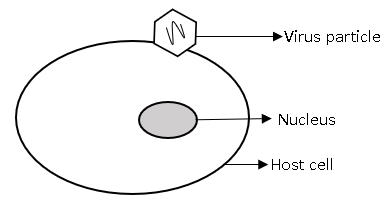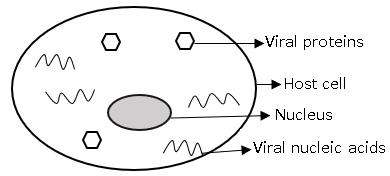This set of Virology Multiple Choice Questions & Answers (MCQs) focuses on “Process of Virus Multiplication”.
1. Which step of virus multiplication cycle is shown in the below diagram?

a) Synthesis
b) Assembly
c) Virion release
d) Adsorption
View Answer
Explanation: All viruses need a host cell to multiply. The attachment of the virus to the host cell is called adsorption. This is the first step in the life cycle of a virus. The attachment of the virus to the host is caused by specific interactions between molecules on the surface of the virus and molecules on the surface of the host cell.
2. Which of the following can be used by virus particles as receptors?
a) Nucleic acid of host cell
b) Mitochondria of host cell
c) Cell wall lipopolysaccharides of host cell
d) Cytoplasm of host cell
View Answer
Explanation: The virus particles interact with specific molecules present on the surface of the host cells for attachment to the host. These molecules are called receptors. Cell wall lipopolysaccharides and proteins of the host cells are used by viruses as receptors. Teichoic acids, flagella, or pili present on the surface of bacterial cells are used by bacteriophages (viruses that are capable of infecting bacteria) as receptors.
3. Which of the following proteins are receptors of human immunodeficiency virus (HIV) particles?
a) CD3 and CCR6
b) CD2 and CCR4
c) CD4 and CCR5
d) CD5 and CCR2
View Answer
Explanation: HIV particles use two different proteins present on human cells for attachment to the host. CD4 and CCR5 are the two host cell receptors that bind with HIV particles. These host molecules normally bind chemokines. Chemokines are signaling molecules used by the immune system.
4. Plant viruses can attach to plant cells by binding to receptors.
a) True
b) False
View Answer
Explanation: Plant viruses are important exceptions to attachment by receptor binding. No receptors have been identified for the plant viruses. Plant viruses enter the host cells through wounds. Plant -eating insects that carry viruses from one plant to another cause damage of the plant cells and help in the entry of virus particles.
5. Which of the following processes is used by viruses to make the viral genome available inside the host cell?
a) Adsorption
b) Uncoating
c) Synthesis
d) Assembly
View Answer
Explanation: Many viruses of the eukaryotic cells enter the host cell’s cytoplasm while their genome is enclosed within the capsid. Once inside the cell, the virus genome must become available for the next steps of the multiplication cycle. So, the viruses shed their capsid proteins. This process is known as uncoating.
6. Which of the following enzymes is used by double-stranded DNA viruses during synthesis stage?
a) Reverse transcriptase
b) Protease
c) DNA polymerase
d) Lipase
View Answer
Explanation: Double-stranded DNA viruses have their genomic information stored in the DNA. During synthesis stage, their DNAs are replicated by enzymes called DNA polymerases. The DNA produces mRNA by transcription. Viral proteins are synthesized from the mRNA by translation.
7. Which step of the virus multiplication cycle is shown in the below diagram?

a) Synthesis
b) Assembly
c) Attachment
d) Virion release
View Answer
Explanation: The synthesis stage of the multiplication cycle is shown in the diagram. This stage begins after the virus enters into the host cells. During this stage, the genes of the virus are transcribed and translated. The virus takes control of the host cell during this stage and forces it to manufacture viral genomes and proteins.
8. What is the function of early proteins produced by viruses?
a) Capsid formation
b) Virion release
c) Assembly
d) Taking control over the host cell
View Answer
Explanation: The proteins synthesized at the early stage of virus infection are called early proteins. They are encoded by early genes. The early proteins are involved in taking control over the host cell. The capsid proteins and the proteins involved in self-assembly and release of the virus particles are called late proteins.
9. Which protein complex helps in the incorporation of DNA into the heads of bacteriophages during the assembly stage of virus multiplication cycle?
a) RNA polymerase
b) DNA polymerase
c) Packasome
d) Ubiquitin
View Answer
Explanation: DNA is incorporated into the head of the bacteriophage by a protein complex known as the packasome. The packasome complex consists of a portal protein, located at the base of the head, and a set of proteins known as the terminase complex, which moves DNA into the head of the bacteriophage.
10. Which proteins are required by bacteriophage T4 to lyse their host cells?
a) Actin and myosin
b) Lysozyme and holin
c) Cadherin and integrin
d) Catenin and vinculin
View Answer
Explanation: Nonenveloped viruses lyse their host cells at the end of the intracellular phase to release virions (complete virus particles). Bacteriophage T4 needs two specific proteins for the lysis of the host cells. One of them is lysozyme, which attacks peptidoglycan in the host’s cell wall. The other one, called holin, creates holes in the host cell’s plasma membrane helping lysozyme to move from the cytoplasm to the peptidoglycan.
11. Which proteins of the host cells are inactivated by oncoviruses?
a) Tumor inducer proteins
b) Tumor suppressor proteins
c) Tumor progression proteins
d) Membrane proteins
View Answer
Explanation: Viruses that can cause cancer are called oncoviruses. Human oncoviruses trigger transformation of host cells by the following mechanism. Oncoviruses encode proteins that bind to and inactivate some host proteins known as tumor suppressor proteins. When tumor suppressor proteins are inactivated, cells undergo uncontrolled reproduction and become hyperproliferative. This leads to the formation of tumors. The tumors are beneficial for the multiplication of viruses.
12. Which of the following molecules is used by Hepatitis B virus as receptor?
a) MHC I
b) MHC II
c) IgA receptor
d) IgG receptor
View Answer
Explanation: The molecules present on the surface of host cells which interact with viruses and help in their attachment are called receptors. IgA receptor is the primary receptor of Hepatitis B virus. The normal function of this molecule is to bind IgA for transport across the cell. But this cell surface molecule is used by Hepatitis B virus to gain entry into the cell.
13. In which stage of virus multiplication cycle new nucleocapsids are produced?
a) Adsorption
b) Synthesis
c) Virion release
d) Assembly
View Answer
Explanation: New nucleocapsids are constructed by self-assembly of the coat proteins with the nucleic acids in the assembly stage of virus multiplication cycle. Proteins and other factors produced by the host cells are also involved in assembling the mature virus particles. The assembly process of viruses is very complicated.
14. Which of the following is the source of envelopes of animal viruses?
a) Host cell membranes
b) Virus nucleic acid
c) Virus capsid protein
d) Host nucleic acid
View Answer
Explanation: The envelopes of animal viruses are derived from host cell membranes. It is a multistep process. At first, virus encoded proteins are incorporated into the membrane, followed by release of nucleocapsid and envelope formation by membrane budding. Apart from the plasma membrane of the host cell, envelopes can also be derived from the endoplasmic reticulum, Golgi apparatus and other internal membranes of the host cell.
15. Low affinity receptor molecules show low specificity while interacting with viruses.
a) True
b) False
View Answer
Explanation: Low affinity receptors are highly abundant molecules present on the surface of the host cells. They show low specificity and low affinity while interacting with the virus particles. These receptors help the viruses to get out of the fluid surrounding the cell and to come in direct contact with the molecules present on the cell surface.
Sanfoundry Global Education & Learning Series – Virology.
To practice all areas of Virology, here is complete set of 1000+ Multiple Choice Questions and Answers.
If you find a mistake in question / option / answer, kindly take a screenshot and email to [email protected]
- Check Biotechnology Books
- Apply for Biotechnology Internship
- Practice Biotechnology MCQs
- Check Virology Books
